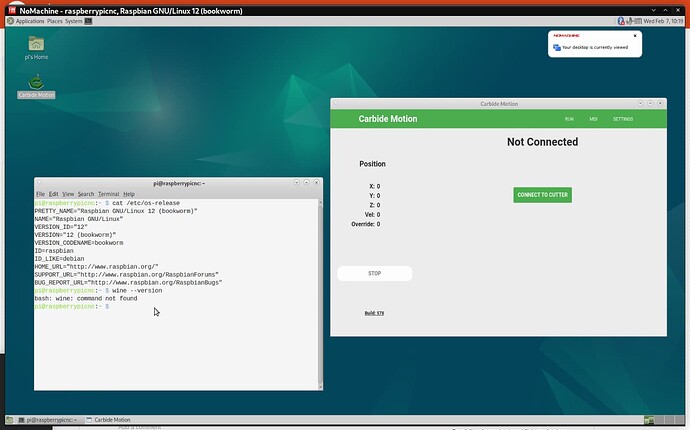Sounds like a great idea but something I should have done at the start. It looks like configuring it to boot from USB requires an update to the currently installed card rather than flipping a switch with a current system.
I did it after having to change the microSD a couple of times and was quite adept at getting the RPi out of the case, but it is a bother. I found a thread that described the steps I posted and it was successful on the first try. Do be aware that, depending on the USB stick, it might take a little longer to boot, but I’m happy with what I have and can experiment to my heart’s content when I want to change OS images.
Thanks, I decided to just update bullseye and then CM. I just completed that and did go through the machine setup as I was never really happy about the centering over the bitsetter.
All is well so far although no cuts have been made.
I can report that going into Quick Actions and then hitting the cancel button still locks up CM for some reason. Hitting the X to get out works but I have a hell of a time getting the tiny X pressed with my fat fingers. I guess I need a touch sensitive pen out in he shop.
Next time I am forced to remove the PI from the case I will definately do the USB boot trick. That has the advantage of preventing one more point of entry for dust into the machine ![]()
Quick Update - I have tested several PI 5’s with the current OS release, setting the User up as Pi and Password Raspberry. I’ve had no problems running CM622 so far.
An update from me as well. Instead of going to bookworm I just updated bullseye as mention in that previous post and I have had no issues although I did apply the “fix”.
One thing I neglected to mention earlier is that the annoying pauses which would hang jogging while using the tech keys 9 key device are gone. I am not sure if it was the bullseye update or the CM update to the lates which solved it.
I had more or less abandoned that tech keys device due to the issue but it now works great.
Is that with using the Wayland mode?
On an HDMI connected monitor or touchscreen?
My current Rpi4 has a DSI connected touchscreen, so would just like some specifics in terms of hardware setup for comparison.
The internet read my mind. The main benefit of a Raspberry device was that it was a cheap computer. It’s no longer cheap, and has never been plug-n-play. If you’re just starting out, research all the options, there’s lots of cheap Windows computers, that you can also put linux on (which is what the raspi runs) if that’s what you like.
Note that the cheap PC running Linux will not be able to run Carbide Motion in a straight-forward fashion if at all.
Seems fine with mine, running Debian.
Are you using Wine for CM?
So what hardware is that running on? You seem to be suggesting that you’re running an ARM coded application on an x86 system without any emulation layer - which doesn’t seem to make any sense.
It’s running on a raspberry pi 4, using the Debian build for Raspberry devices.
Yeah that is why people are confused. The devise Jeff Geerling is comparing a Pi to in that video is has an x86 processor. You cannot just run the .deb package for the pi in an x86.
Maybe I wasn’t clear earlier. I’d expect someone to install the version of linux that matches their instruction set. You can run a .deb on an x86 if you have the proper version of linux.
Correct, but Carbide3D only has an arm version of Carbide Motion in .deb form. There is no x86 .deb for it.
Ah, that makes more sense. Now I see what ppl are getting at. CC runs so well on my other computer that I forget it’s running through POL.
This topic was automatically closed 30 days after the last reply. New replies are no longer allowed.

